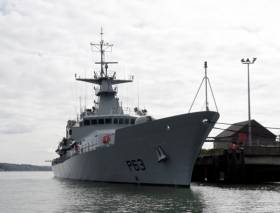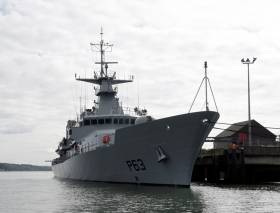Displaying items by tag: LE William Butler Yeats
LÉ William Butler Yeats Makes Maiden Call to Dun Laoghaire As East Pier Strollers Look On
#FirstVisit - LÉ William Butler Yeats, the third OPV90 class with another sister on order costing €55m, departed Dun Laoghaire Harbour having made a maiden call this weekend, writes Jehan Ashmore.
The latest OPV90 class otherwise known as the ‘Samuel Beckett’ series named after the leadship, has been in Irish waters since July following a delivery voyage to Cork Harbour from UK shipbuilder, Babcock Marine. At the time of launch, the Naval Service announced “preparatory work for the contract extension to build a fourth OPV was well underway with production due to start in August.”
As reported yesterday LÉ William Butler Yeats was alongside Dun Laoghaire's Carlisle Pier, where almost a year ago second sister, LÉ James Joyce was named at the same quay. L.É. Samuel Beckett is currently returning to the Mediterranean to replace L.É. James Joyce. She is heading back home next Friday after a three month migrant search and rescue deployment at sea.
Adjacent of the Carlisle Pier is the East Pier, easily the more popular of Dun Laoghaire's two piers, where strollers could see the 1,900 displacement tonnes vessel. The newcomer which has a crew of 44 personal and is equipped notably with Unmanned Aerial Vehicles (UAV). They are used for a variety of tasks, among them covert drug interdiction duties and pollution detection.
In addition the OPV's 90m long hull is to improve sea keeping characteristics, to cope when patrolling the more exposed Atlantic Ocean. At the stern there is a derrick crane and additional space for deck cargo, i.e. TEU sized containers (for stores, supplies and equipment), varying to what is required when on deployment.
The OPV90 trio represent phase one of a modernisation/ vessel replacement programme that has led all ageing ‘Emer’ OPV class decommissioned, though the disposal of LÉ Aisling remains to be seen. With the entry of LÉ William Butler Yeats, she along with her sister make up the largest of the same class out of fleet of eight, that includes a similar pair of the ‘Roisin’ class OPV80 sisters.
Next month, a twinning ceremony of LÉ William Butler Yeats is to be held next month Galway. The City of the Tribes is the adopted homeport of her direct predecessor, LÉ Aisling.
The veteran vessel likewise of her older sisters was built by Verolme Cork Dockyard, with LÉ Aisling commissioned in 1980. She would serve a 36 year career until this summer when she was decommissioned.
Newest Naval Service OPV LÉ William Butler Yeats Makes Maiden Call to Dun Laoghaire
#FirstVisit - The newest Naval Service patrol vessel, LÉ William Butler Yeats, the third so far of the OPV90 class has made a maiden call to Dun Laoghaire Harbour this afternoon, writes Jehan Ashmore.
LÉ William Butler Yeats made her delivery voyage from UK shipbuilders to Cork Harbour in July, had berthed alongside Dun Laoghaire's Carlisle Pier (No 2 berth) this afternoon. The 90m newbuild will remain until Sunday afternoon. On this first call the OPV will not be open to the public.
A twinning ceremony of LÉ William Butler Yeats is to he held next month in city of Galway, the adopted homeport of her direct replacement, LÉ Aisling. The veteran Emer class OPV dating from 1980 was in the summer decommissioned.
Designed by Vard Marine and built at Babcock Marine in Appledore, north Devon, the newbuild follows a previous pair of the OPV90 class or Samuel Beckett-class in which the namesake ship departed Cork Harbour today to the Mediterranean. This is her second deployment for search and rescue mission of migrants.
The second OPV sister LÉ James Joyce, last year was named at a ceremony held in Dun Laoghaire Harbour, whereas proceedings for the LÉ Samuel Beckett took place at Dublin’s city quays.
Together they were ordered by the Department of Defence under a £81m contract from Babcock Marine in October 2010, with the option of a third vessel.
LÉ William Butler Yeats which was floated out in March at the Appledore shipyard near Bideford.
Newest Naval Service Vessel To Be Twinned With Galway Next Month
#Navy - Taoiseach Enda Kenny will officiate the twinning of the new Naval Service vessel LÉ William Butler Yeats with the city of Galway on Monday 17 October, as the Connacht Tribune reports.
The City of the Tribes was previously linked with the LÉ Aisling, which was decommissioned this past summer and is now being proposed as the home of a floating museum in Galway Docks.
Designed by Vard Marine and built by Babcock Marine in Appledore, north Devon, LÉ William Butler Yeats is in the same class OPV90 as sister ships LÉ Samuel Beckett and LÉ James Joyce, delivered in 2014 and 2015 respectively.
On a visit to the new vessel in Haulbowline last month, Defence Minister Paul Kehoe described its arrival and entry into service as "another key milestone in the history of the Naval Service".
#NewestOPV90 - The newest addition to the Naval Service fleet, the OPV90 class LÉ William Butler Yeats (P63) was boarded by Minister with Responsibility for Defence, Mr. Paul Kehoe yesterday Haulbowline, Cork Harbour
The Minister was welcomed on board by the Flag Officer Commanding Naval Service Commodore Hugh Tully and the ship’s Captain Lieutenant Commander Eric Timon.
The ship is the same class as LÉ Samuel Beckett (P61), delivered in 2014 and LÉ James Joyce (P62) delivered in 2015. The ship recently completed successful Sea Acceptance Trials in the United Kingdom and arrived in the Naval Base last month on Saturday 23rd July, following a handover from the shipyard as previously reported on Afloat.ie
LÉ William Butler Yeats will be formally commissioned later in the autumn and is replacing the recently decommissioned LÉ Aisling (P23) in service.
Minister Kehoe said that “the arrival of LÉ William Butler Yeats and its entry into service is another key milestone in the history of the Naval Service. In light of operational demands the provision of key equipment such as this is extremely important. I am pleased that the ship is destined to play an integral part in the protection of Irish maritime waters for many years to come and will also be available to participate in humanitarian operations such as Operation Pontus in the Mediterranean Sea.
The Government remains fully committed to ensuring that appropriate resources are provided going forward to enable the Defence Forces to carry out all of the roles assigned to them. The Government has provided a significant boost in capital funding for the Defence Sector for the period up to 2021, which will allow for considerable investment in equipment and infrastructure based on the priorities set out in the White Paper on Defence.”
The Minister went on to wish the Captain and his crew the best of luck as they continue to work the ship up to full operational capacity.
#ThirdOPV90 - According to NavalTechnology.com, the Naval Service has reportedly floated out the third and final OPV90 / Samuel Beckett-class newbuild LÉ William Butler Yeats (P63).
A total of two Samuel Beckett-class OPVs were ordered by Ireland's Department of Defence under a £81m contract from Babcock Marine in October 2010, with the option of a third vessel.
In June 2014, the department exercised the option under the original contract to place an order for the third OPV, which was scheduled for delivery in the middle of this year.
Float out of L.É. William Butler Yeats time lapse videoFloat out of L.É. William Butler Yeats time lapse video
Posted by Irish Naval Service on Friday, 11 March 2016
Designed by Vard Marine, the OPVs replace three earlier vessels, the 'Deirdre' Class LE Emer, LE Aoife and LE Aisling, which were commissioned with the Irish Naval Service between 1978 and 1984. To read more click here.
Afloat adds the second 'Beckett' class OPV90 LE James Joyce (P62) was last year commissioned into service and named in a joint ceremony held in Dun Laoghaire Harbour.


































































